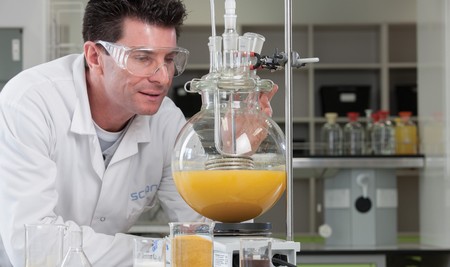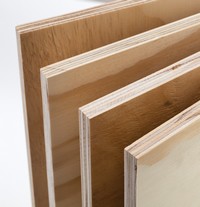Taking our bioadhesive technology to industry

Dr Warren Grigsby and his research team are making their bioadhesives commercially available.
Scion’s environmentally-friendly bioadhesives and resins made from natural sources, are contributing to a reduction in the use of fossil resources and greenhouse gas emissions, reinforcing the New Zealand wood processing industry’s licence to operate.
The winding road to commercialisation
It’s been a long and sometimes sticky road to success for Scion’s bioadhesives research team.
After seven years of learning to mix and match assorted ingredients from forestry and agricultural waste to produce a recipe for a healthy ‘green’ bio-based adhesive, the research team is ready to take their technology to the next step, industrial commercialisation.
The commercial availability of Scion’s bioadhesives to the wood processing industry comes on the back of commercial trials held late last year, which involved the manufacture and product testing of the liquid resins at tonne-scale. Following this, commercial-scale trials were run at two industrial plywood mills, each using two different types of adhesive application.
Programme leader, Dr Warren Grigsby, says the trials were a great success. “We had to deal with a few teething problems along the way and learned new things in the process, but we’re very happy with the outcomes.
“The mills had their own unique conditions and challenges to overcome. For example, each used different equipment with specific requirements, and the veneers they were using had different characteristics, but we were able to adapt our product to suit the different glue application methods of each mill and produce the desired result.”
Warren likens it to baking a cake where a range of products can be made by combining different ingredients. In this case, adhesives were adapted to suit interior grade plywood and laminated veneer lumber products. “Different formulations of adhesive have different properties, and the blend of ingredients depends on what wood finish is being used, and the composite or wood panel being manufactured.”
Getting the recipe right
 New Zealand manufacturers of medium density fibreboard (MDF) have been looking at ways to reduce formaldehyde emissions of products for many years, in response to regulatory pressure from overseas markets. In late 2008, Scion initiated a research programme to create ‘green’ bioadhesives without using formaldehyde or petrochemicals.
New Zealand manufacturers of medium density fibreboard (MDF) have been looking at ways to reduce formaldehyde emissions of products for many years, in response to regulatory pressure from overseas markets. In late 2008, Scion initiated a research programme to create ‘green’ bioadhesives without using formaldehyde or petrochemicals.
Warren and his team had to start from scratch, extracting chemicals from forestry and agricultural residues such as Kraft liquor from pulp and paper mills, and arable crop processing waste. They then re-formulated the ingredients in new ways to create the building blocks for bioadhesives. After suffering a few flops along the way, the team eventually developed a recipe capable of holding together an MDF panel, and things started cooking from there.
And, says Warren, the products’ green credentials will provide manufacturers with a competitive advantage over wood panel processers using conventional petrochemical adhesives and resins.
“Adhesives and resins made from natural sources have a lower environmental footprint and are considered more socially acceptable than their traditional formaldehyde-based counterparts. We conducted an analysis of our bioadhesives in 2014, which showed the engineered wood products have a 22% lower environmental impact over their lifecycle than those using adhesives derived from petrochemicals.”
Warren also spent several weeks at the Forest & Forest Products Research Institute in Japan last year, working on a collaborative project to assess emissions produced from wood panels made using bioadhesives, and their individual components.
“We measured the volatile organic compounds emitted during the hot press manufacturing of hardwood plywood panels made using our bioadhesives, and the subsequent emissions released over seven days. The results clearly showed that our bioadhesives have very low formaldehyde emissions, which were lower than wood alone, and that the use of our ingredients contributed to this.
“While we are still developing some of the fundamentals, such as the heat and flow interactions, we can confidently say our ingredients and formulations can be prepared to be truly recyclable, compostable or durable in engineered wood products and packaging.”
What does commercial success look like for bioadhesives?
 In New Zealand, 20% of the plywood manufactured is interior grade and used for wall linings, doors and furniture. Warren would eventually like to see all interior grade plywood made using bioadhesives to support a healthier living environment for kiwis.
In New Zealand, 20% of the plywood manufactured is interior grade and used for wall linings, doors and furniture. Warren would eventually like to see all interior grade plywood made using bioadhesives to support a healthier living environment for kiwis.
At this stage, seeing a range of quality furniture made from wood panels using ‘green’ bioadhesives will be a well-deserved reward for seven years in the Scion master kitchen. The panels produced during the commercial trials have already been released to several design companies to see what they come up with.
The next step towards commercialisation of the products will be to fine tune formulations for the wider engineered wood products and panels market, and for the packaging industry for use in liner and corrugated packaging boards.
Gold icing on top
The bioadhesives research programme received a Gold ranking by the Ministry of Business, Innovation and Employment, for performance and outcomes that exceed expectations on an annual reporting basis.
This is a well-deserved icing on top the programme’s success for Warren and the research team, after years of hard work to develop suitable products for scale-up, fostering industry relationships and international connections, and achieving the necessary steps towards commercialisation.
Sweet reward for a small, dedicated team of scientists.
For further information
Contact Dr Warren Grigsby
